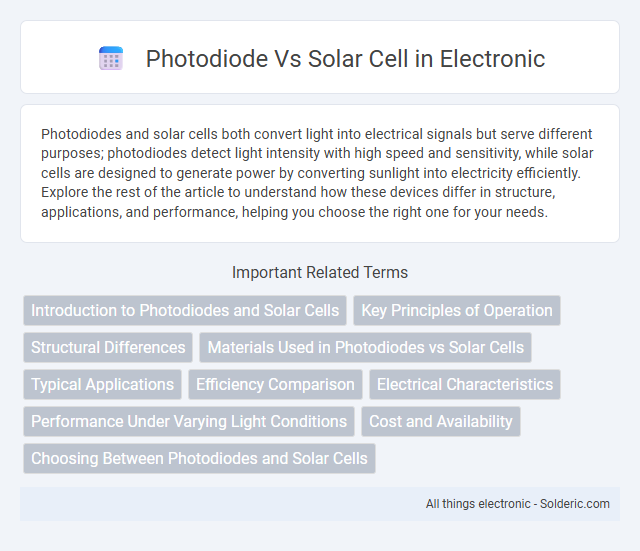Photodiodes and solar cells both convert light into electrical signals but serve different purposes; photodiodes detect light intensity with high speed and sensitivity, while solar cells are designed to generate power by converting sunlight into electricity efficiently. Explore the rest of the article to understand how these devices differ in structure, applications, and performance, helping you choose the right one for your needs.
Comparison Table
| Feature | Photodiode | Solar Cell |
|---|---|---|
| Primary Function | Convert light into electrical current (photodetection) | Convert sunlight into electrical energy (power generation) |
| Operating Principle | Photoconductive or photovoltaic effect for sensing light | Photovoltaic effect for energy conversion |
| Typical Output | Low current, meant for signal processing | High current, suitable for power supply |
| Material | Silicon, InGaAs, or other semiconductor materials | Primarily silicon, with thin-film variants |
| Efficiency | Measurement sensitivity optimized, not energy efficiency | Energy conversion efficiency ranges 15%-22% |
| Application | Optical communication, light metering, sensors | Solar panels, renewable energy systems |
| Response Time | Fast response, nanoseconds to microseconds | Slower response, seconds to minutes |
| Cost | Relatively low cost per unit | Higher initial investment for energy generation |
| Size | Small, compact devices | Larger panels or modules |
Introduction to Photodiodes and Solar Cells
Photodiodes and solar cells are semiconductor devices that convert light into electrical energy but serve different purposes and operate under distinct principles. Photodiodes are designed primarily for light detection, providing fast response times and high sensitivity in applications such as optical communication and sensing. Solar cells focus on maximizing power generation from sunlight, using larger semiconductor junctions and materials optimized for energy conversion efficiency in photovoltaic systems.
Key Principles of Operation
Photodiodes operate based on the photoelectric effect, where incident light generates electron-hole pairs, creating a current proportional to the light intensity, primarily used for light detection and measurement. Solar cells function similarly by converting sunlight directly into electrical energy through the photovoltaic effect, but they are optimized for power generation with larger surface areas and higher efficiency materials. While photodiodes emphasize sensitivity and response speed, solar cells prioritize maximum energy conversion efficiency and durability under varying light conditions.
Structural Differences
Photodiodes typically have a p-n junction designed for fast response and low capacitance, with a thin depletion region optimized for converting light into electrical signals. Solar cells feature a larger p-n junction with a thick depletion layer to maximize photon absorption and enhance current generation for power output. The structural distinction lies in photodiodes prioritizing sensitivity and speed, while solar cells emphasize energy conversion efficiency through their larger active area and junction design.
Materials Used in Photodiodes vs Solar Cells
Photodiodes are typically made from semiconductor materials such as silicon, germanium, or gallium arsenide, chosen for their fast response times and sensitivity to specific light wavelengths. Solar cells primarily use silicon, including monocrystalline, polycrystalline, or amorphous forms, optimized for efficient conversion of sunlight into electrical energy over a broad spectrum. Your choice between these devices depends on whether you need precise light detection or maximum energy harvesting based on the material properties.
Typical Applications
Photodiodes are primarily used in optical communication systems, light sensing, and medical devices for precise light detection and signal conversion. Solar cells are widely employed in renewable energy applications, such as powering residential and commercial buildings, solar farms, and portable electronics, by converting sunlight into electricity. The key distinction lies in photodiodes focusing on light measurement accuracy, while solar cells emphasize efficient energy generation.
Efficiency Comparison
Photodiodes typically exhibit higher efficiency in converting light into electrical signals under low light conditions, making them ideal for sensing applications, whereas solar cells are optimized for maximum energy harvesting under varying sunlight intensities with efficiencies ranging from 15% to 22% in commercial models. Your choice depends on whether you prioritize precise light detection or large-scale energy generation, as solar cells excel in photovoltaic efficiency over extended surfaces while photodiodes perform better in rapid response and sensitivity. Advances in materials like perovskites are driving improvements in solar cell efficiency, but photodiode technology remains superior for applications requiring fast and accurate light measurement.
Electrical Characteristics
Photodiodes exhibit fast response times and low photocurrent, generating current in the microampere range under illumination, making them ideal for sensor applications requiring precise light detection. Solar cells, designed for energy conversion, produce higher photocurrents in the milliampere to ampere range with lower voltage output, optimized for maximum power generation under sunlight. The electrical characteristics of photodiodes include low dark current and high sensitivity, while solar cells emphasize high current density and efficient charge collection for power output.
Performance Under Varying Light Conditions
Photodiodes exhibit faster response times and higher sensitivity to low light levels compared to solar cells, making them ideal for precise light measurement applications. Solar cells generate higher power output under strong sunlight but their efficiency drops significantly in low or fluctuating light conditions. The differing semiconductor structures influence their performance; photodiodes excel in detecting light intensity changes, while solar cells prioritize energy conversion efficiency.
Cost and Availability
Photodiodes typically cost less than solar cells due to simpler manufacturing processes and are widely available in various sizes for electronic applications. Solar cells, designed for energy generation, have higher production costs driven by materials like silicon and are available mainly through specialized suppliers. The broader market presence of photodiodes supports diverse industrial uses, while solar cells dominate renewable energy projects despite higher initial investment.
Choosing Between Photodiodes and Solar Cells
Photodiodes excel in high-speed light detection and precise light measurement applications, making them ideal for optical communication and sensor systems. Solar cells prioritize energy conversion efficiency and large-area light absorption, which suits them for power generation in renewable energy projects. Selecting between photodiodes and solar cells depends on whether the primary requirement is accurate light sensing or maximizing electrical energy output from sunlight.
Photodiode vs solar cell Infographic

 solderic.com
solderic.com